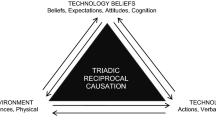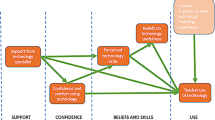Abstract
THIS ARTICLE DESCRIBES the PT3 Implementation Grant at the University of Rhode Island’s School of Education and the impact it had on students’ confidence in using technology for teaching. The three-year project focused on working with faculty from the School of Education and the College of Arts and Sciences to integrate technology into their instruction and improve the supervision of pre-service teachers. The goal was to provide exemplary models of pedagogically sound technology use that were embedded in core teacher education courses, and not through a stand-alone “technology for teachers” course. A technology confidence survey was administered to students in the teacher education program at the end of each semester of the three-year project. Data from the survey were analyzed to look at change in attitudes over time as students progressed through the teacher education program. Results show a significant increase in students’ confidence in six areas of technology use in teaching, the majority of which were a focus of the project’s training and support of university instructors.
Similar content being viewed by others
Explore related subjects
Discover the latest articles, news and stories from top researchers in related subjects.References
Bull, G.L., & Cooper, J.M. (1997). Technology and teacher education: Past practice and recommended directions.Action in Teacher Education, 19(2), 97–106.
Casey, C. (1996). Incorporating cognitive apprenticeship in multi-media.Educational Technology, Research, and Development, 44(1), 71–84.
Christensen, R., & Knezek, G. (2000). Internal consistency reliabilities for 14 computer attitude scales.Journal of Technology and Teacher Education, 8(4), 327–336.
Collins, A., Brown, J.S., & Newman, S.E. (1989). Cognitive apprenticeship: Teaching the craft of reading, writing and mathematics. In L.B. Resnick (Ed.),Knowing, learning and instruction: Essays in honor of Robert Glaser (pp. 453–494). Hillsdale, NJ: Lawrence Erlbaum Associates, Inc.
Delcourt, M.A.B., & Kinzie, M.B. (1993). Computer technologies in teacher education: The measurement of attitudes and self-efficacy.Journal of Research and Development in Education, 27(1), 35–41.
Ertmer, P.A. (2001). Responsive instructional design: Scaffolding the adoption and change process.Educational Technology, 41(6), 33–38.
George, G., & Camarata, M.R. (1996). Managing instructor cyber anxiety: The role of self-efficacy in decreasing resistance to change.Educational Technology, 36(4), 49–54.
Good, K. (1996). Integrating technology into education preservice special education teachers.Action in Teacher Education, 17(4), 53–63.
Gunter, G.A. (2001). Making a difference: Using emerging technologies and teaching strategies to restructure an undergraduate technology course for pre-service teachers.Education Media International, 38(1), 13–20.
Hargrave, C.P., & Hsu, Y. (2000). Survey of instructional technology courses for preservice teachers.Journal of Technology and Teacher Education, 8(4), 303–314.
Hunt, N.P., & Bohlin, R.M. (1993). Teacher education students’ attitudes toward using computers.Journal of Research on Computing in Education, 25(4), 487–497.
International Society for Technology in Education (1999).Will new teachers be prepared to teach in a digital age? A national survey on information technology in teacher education. Research study commissioned by the Milken Exchange on Education Technology. Santa Monica, CA: Milken Exchange on Education Technology.
International Society for Technology in Education (2002).National educational technology standards for teachers: Preparing teachers to use technology. Eugene, OR: International Society for Technology in Education.
Jarvela, S. (1995). The cognitive apprenticeship model in a technologically rich learning environment: Interpreting the learning interaction.Learning and Instruction, 5, 237–259.
Jarvela, S. (1998). Socioemotional aspects of students’ learning in a cognitive-apprenticeship environment.Instructional Science, 26, 439–472.
Jennings, S.E., & Onwuegbuzie, A.J. (2001). Computer attitudes as a function of age, gender, math attitude, and developmental status.Journal of Educational Computing Research, 25(4), 367–384.
Johnson, D. (2002). Electronic dialoguing in a preservice reading methods course: A yearlong study.Reading Online, 6(1). Retrieved May 16, 2005, from http://www.readingonline.org/articles/art_index.asp?HREF=johnson/index.html.
Kinzie, M.B., Delcourt, M.A.B., & Powers, S.M. (1994). Computer technologies: Attitudes and self-efficacy across undergraduate disciplines.Research in Higher Education, 35(6), 745–768.
Lemke, C., & Coughlin, E.C. (1998).Technology in American schools: Seven dimensions for gauging progress. Report commissioned by the Milken Exchange on Education Technology. Santa Monica, CA: Milken Exchange on Education Technology.
LePage, P., Lewis, A., & Casella, V. (1995). The effect of technology instruction on preservice teachers’ confidence to teach special learners.Reading Improvement, 32(3), 161–171.
Liu, M., Reed, W.M., & Phillips, P.D. (1992). Teacher education students and computers: Gender, major, prior computer experience, occurrence, and anxiety.Journal of Research on Computing in Education, 24(4), 457–467.
Marcinkiewicz, H.R. (1994). Computers and teachers: Factors influencing computer use in the classroom.Journal of Research on Computing in Education, 26(2), 220–235.
Marcinkiewicz, H.R. (1995). Differences in computer use of practicing versus preservice teachers.Journal of Research on Computing in Education, 27(2), 184–197.
Milbrath, Y.L., & Kinzie, M.B. (2000). Computer technology training for prospective teachers: Computer attitudes and perceived self-efficacy.Journal of Technology and Teacher Education, 8(4), 373–396.
Pope, M., & Hare, D., & Howard, E. (2002). Technology integration: Closing the gap between what preservice teachers are taught to do and what they can do.Journal of Technology and Teacher Education, 10(2), 191–203.
President’s Panel on Educational Technology (1997).Report to the president on the use of technology to strengthen K-12 education in the United States. Washington, D.C.: President’s Committee of Advisors on Science and Technology.
Schacter, J. (1999).The impact of education technology on student achievement: What the most current research has to say. Research study commissioned by the Milken Exchange on Education Technology. Santa Monica, CA: Milken Exchange on Education Technology.
Schrader, P.G., Leu, D.J., Jr., Kinzer, C.K., Ataya, R., Teale, W.H., Labbo, L.D., & Cammack, D. (2003). Using Internet delivered video cases, to support pre-service teachers’ understanding of effective early literacy instruction: An exploratory study.Instructional Science, 31, 317–340.
Shabo, A., Guzdial, M., & Stasko, J. (1997). An apprenticeship-based multimedia courseware for computer graphics studies provided on the World Wide Web.Computers & Education, 29(2/3), 103–116.
Sherry, A.C. (2000). Expanding the view of preservice teachers’ computer literacy: Implications from written and verbal data and metaphors as freehand drawings.Journal of Technology and Teacher Education, 8(3), 187–218.
Siegel, S., & Castellan, N.J., Jr. (1988).Nonparametric statistics for the behavioral sciences (2nd ed.). New York: McGraw-Hill.
Wetzel, K. (1993). Teacher educators’ uses of computers in teaching.Journal of Technology and Teacher Education, 1(4), 335–352.
Willis, J.W., & Mehlinger, H.D. (1996). Information technology and teacher education. In J. Sikula (Ed.),Handbook of research on teacher education (pp. 978–1029). New York: Macmillan Library Reference.
Author information
Authors and Affiliations
Additional information
About the AuthorsPeter Adamy is an Associate Professor of Elementary Education in the School of Education at the University of Rhode Island. His main area of research is the use of technology in teaching and assessment, with a specific focus on teacher education. He teaches methods of assessment, evaluation, and research in education.
John Boulmetis is a Professor of Adult Education in the School of Education, and Director of the Institute for Human Science and Services at the University of Rhode Island. His research and teaching focus on evaluation, assessment, and research in education, with an emphasis on adult and career and technical education.
Rights and permissions
About this article
Cite this article
Adamy, P., Boulmetis, J. The impact of modeling technology integration on pre-service teachers’ technology confidence. J. Comput. High. Educ. 17, 100–120 (2006). https://doi.org/10.1007/BF03032700
Issue Date:
DOI: https://doi.org/10.1007/BF03032700




